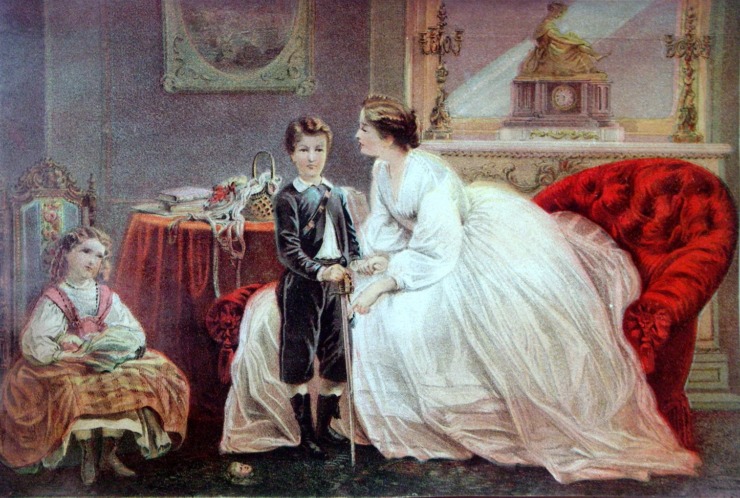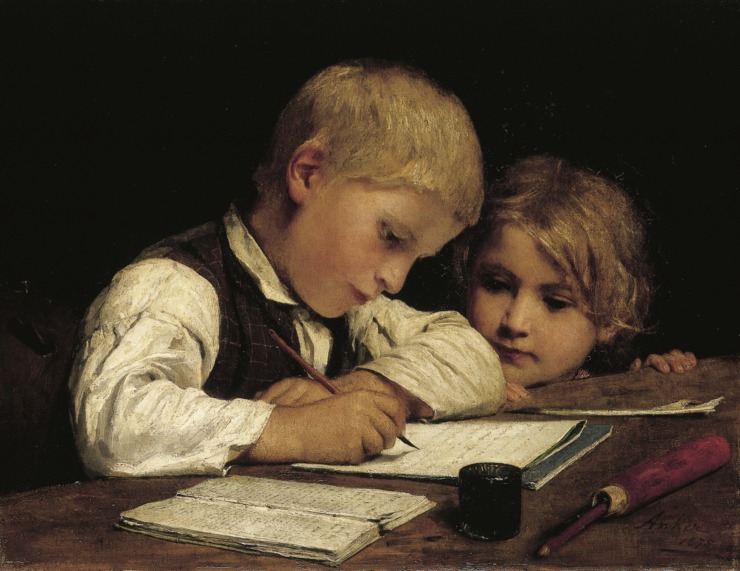A Song About Myself
There was a naughty boy,
A naughty boy was he,
He would not stop at home,
He could not quiet be-
He took
In his knapsack
A book
Full of vowels
And a shirt
With some towels,
A slight cap
For night cap,
A hair brush,
Comb ditto,
New stockings
For old ones
Would split O!
This knapsack
Tight at’s back
He rivetted close
And followed his nose
To the north,
To the north,
And follow’d his nose
To the north.
II.
There was a naughty boy
And a naughty boy was he,
For nothing would he do
But scribble poetry-
He took
An ink stand
In his hand
And a pen
Big as ten
In the other,
And away
In a pother
He ran
To the mountains
And fountains
And ghostes
And postes
And witches
And ditches
And wrote
In his coat
When the weather
Was cool,
Fear of gout,
And without
When the weather
Was warm-
Och the charm
When we choose
To follow one’s nose
To the north,
To the north,
To follow one’s nose
To the north!
III.
There was a naughty boy
And a naughty boy was he,
He kept little fishes
In washing tubs three
In spite
Of the might
Of the maid
Nor afraid
Of his Granny-good-
He often would
Hurly burly
Get up early
And go
By hook or crook
To the brook
And bring home
Miller’s thumb,
Tittlebat
Not over fat,
Minnows small
As the stall
Of a glove,
Not above
The size
Of a nice
Little baby’s
Little fingers-
O he made
‘Twas his trade
Of fish a pretty kettle
A kettle-
A kettle
Of fish a pretty kettle
A kettle!
IV.
There was a naughty boy,
And a naughty boy was he,
He ran away to Scotland
The people for to see-
There he found
That the ground
Was as hard,
That a yard
Was as long,
That a song
Was as merry,
That a cherry
Was as red,
That lead
Was as weighty,
That fourscore
Was as eighty,
That a door
Was as wooden
As in England-
So he stood in his shoes
And he wonder’d,
He wonder’d,
He stood in his
Shoes and he wonder’d.
-John Keats
Enjoy Artistic Representations of “A Song About Myself” by John Keats

Victorian picture depicting a mother rebuking her son for beheading his sister’s doll, 1885.

Boy writing with his sister by Albert Anker, 1875
Listen to Readings of “A Song About Myself”
Listen to this Musical Interpretation of “A Song About Myself” by John Keats
John Keats Biography
Keats was born in London on Oct. 31, 1795; a few weeks later he was baptized at St. Botolph Without Bishopsgate Church, near where his parents lived and father worked as the manager of a stable owned by his father-in-law. Keats was the eldest of four children, with George, Tom, and Fanny following him. The family was well off enough that the boys were sent to Clark’s Academy in Edmonton at what is now the north London borough of Enfield for their education; it was riding his horse home from a visit to the school that Keats’ father fell and died the next day. His mother remarried (rather quickly, in fact), fought with the rest of the family, and died fairly young from consumption or tuberculosis, which was all too common at the time and would eventually claim the life of Keats’ youngest brother, Tom, as well as Keats himself.
He was apprenticed to a local doctor, but the relationship didn’t seem to work too well. He ended up working at St. Guy’s Hospital in the Southwark district of London, continuing his medical training and writing poetry (the site of the original St. Guy’s in now occupied by London’s tallest office building, known locally as “The Shard”).
While Keats had numerous city connections (Anita Miller also has a “Keats in the City” walk), it is with Hampstead that he is most closely associated. Fellow poets lived there, as did the editor who first published his poetry. Artists whom Keats associated with lived there. Keats himself would move there with his brothers. Keats and his friends would wander Hampstead Heath, talking and arguing poetry and the issues of the day. After moving into Wentworth House in Hampstead, Keats wrote five of six famous odes, including “Ode to a Nightingale.” And it would be at Wentworth House in Hampstead that Keats would realize that he was dying from the same disease that took his mother and younger brother.
Enjoyed A Song About Myself by John Keats and want to know more about Keats’ life? Try A Month With Keats: A Walk Into His Life
That’s it for A Song About Myself!
BUY ‘HOW TO WRITE A FORM POEM’ NOW!
